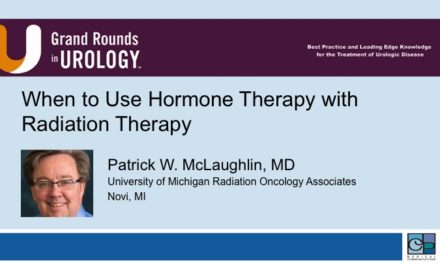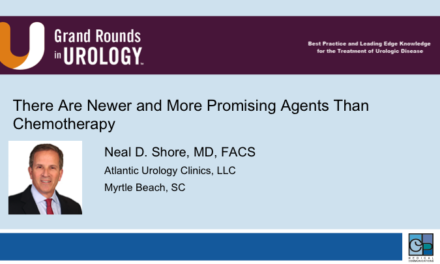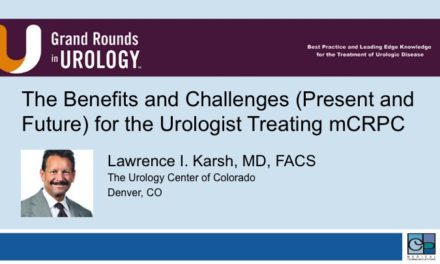Keywords: prostate cancer, screening, PSA, biopsy, ERSPC, PLCO
How to cite: Andriole, Gerald. “Prostate Cancer Screening: What We’ve Learned and Where We Should Go” Grand Rounds in Urology. January 21, 2016. Apr 2024. https://dev.grandroundsinurology.com/prostate-cancer-screening-what-we-learned.
Transcript
Prostate Cancer Screening: What We’ve Learned and Where We Should Go
As David alluded to, we’ve gotten into a lot of trouble with the way we’ve been doing PSA testing over the last 15-20 years. So, here’s the first question I’d like to pose to you; what is the most common age stratum of men in the United States who are getting a PSA test? Is it men between 45-50, 50-55, 55-60? 65-70, or 70-75? If you could just vote for the group by 5-year age stratum that you think is most likely to be tested with PSA.
Well, I’m going to show you that it’s actually men between the ages of 70 and 75, and that’s been a huge part of the problem, and it’s not urologists doing it, mind you. As we heard, it’s probably more likely our family doctor internist colleagues. How about the next question? The 2015 NCCN recommendation for biopsy–to consider biopsy–is it a PSA level of 2 or 2.5, 3, 4, or it should be age adjusted? The latest NCCN guidelines.
In some sense it is true, but you’ll see later on that it’s actually at 3. Since this is a CME, here are my disclosures. You can see the various companies and the two institutes from the national institutes of health.
I’d like to give an overview of screening. I’d like to talk at a high level about the results of the big randomized trials, and then review some of the specialty guidelines. I actually won’t be touching this because many of the later speakers will be going into a lot of this in a lot more detail than I can.
So, here’s the top level summary of where we stand. Based on what we’ve been doing, mass screening on the basis of age alone has a small effect on prostate cancer mortality. It’s either somewhere between 0.0-0.9 absolute risk reduction, in other words, the average U.S. man has about a 3%; if you put in some of the best results, you can lower that chance of dying to prostate cancer down to 2.1%.
As we’ll show, PLCO didn’t show a benefit; ERSPC did show a 20-30% relative risk reduction in a subgroup. There’s certainly some limitations to that trial, as well as PLCO, and we’ll talk about those. But, the real problem, as we’ve talked about for the last couple of years has been a significant risk of over-diagnosis, and a significant risk of over-treatment, and those are the things that have really hampered us.
There are a lot of factors that promote the over-diagnosis of prostate cancer, and this was a nice review article by Gill Welch a few years ago. I put it to you that prostate cancer really could be the poster child, because it does fulfill each one of those factors that promote the over-diagnosis of a cancer.
I want to say it’s not just prostate cancer that when you screen for it you over-diagnose. It’s true for thyroid cancer, it’s true for breast cancer, and it may be true for some of the other cancers, as well. Recently NCI, in conjunction with Oxford, had a 3-day conference on how to minimize the over-diagnosis of prostate cancer.
So, everybody knows there’s a huge reservoir of prostate cancer just waiting to be discovered by the process of putting a needle into the prostate. You can see the relatively high rates of cancer in both black and white ment, and a little bit underappreciated, it’s even true in Asian men. There’s a very fine study from Alex Zlotta that came out a year or two ago, that not withstanding a very low death rate from prostate cancer, there’s a pretty high autopsy rate of prostate cancer in Asian men; in this case it was Japanese men.
When you crunch the numbers as Vickers is known to do, he took data from the PCPT trial where there was annual repeat screening, and based only on sextant biopsy. If you bootstrap that analysis and consider only men who started out with a PSA of less than 1.0, after 25 years you would have found three times as many cases of prostate cancer as you would have expected to be clinically diagnosed.
You would have found 21.6 times as many cases as men would have ever developed metastatic disease, and you would have found 65 as many cases for every man who actually died of prostate cancer. So, there’s a real great opportunity with serial PSA testing, and even just a crummy sextant biopsy to over-diagnose prostate cancer.
But, as I said, it’s not just prostate cancer. Here’s a summary of what’s been going on with mammogram-based screening for breast cancer. You can see a high rate of false positives, unnecessary biopsies, and 57 out of the 302 were cases were considered to be over-diagnosed. That’s despite the fact that the mortality benefits of mammography are really not well-established.
There’s a recent summary showing that when you look at different counties throughout the United States, the more mammograms that are done in the counties increases the incidence of the disease, but it really doesn’t change very much the breast cancer mortality. David already showed this slide, that mammography as presently practiced is unable to reduce the incidence of metastatic disease, whereas we certainly know that PSA testing can.
I mentioned to you about thyroid cancer. The Koreans are doing an experiment right now, they started screening with ultra-sonography for thyroid cancer, and you can see how they’ve increased the incidence of that disease. This is what is happening in the United States where there’s no organized screening, but here is the mortality from thyroid cancer, well below 1.1% in both of those countries.
If you start looking for cancers, you’re going to find them. The problem with over-diagnosis, as we all know, is that it ruins peoples’ lives, and in the case of prostate cancer, this study from a number of years ago showed that even men without a history of cardiac events, within a week or a month after being told they had prostate cancer had between a 3- and a 4-fold increased chance of sustaining a major cardiovascular event.
The message we give over the phone that this is a toothless lion, don’t worry about it, isn’t being translated to the patients. Even an increased risk of suicide in the next 30 days after a prostate cancer diagnosis.
These are some studies from the ERSPC that Fritz Schroeder published a year ago showing that there’s nothing we do in screening for prostate cancer that improves a man’s quality of life. In comparison to the control group of ERSPC, the screened guys were a lot worse. The only time they got better was if you prevented the institution of endocrine therapy. Every step along the way prior to that only ruins a man’s life.
This is why the World Health Organization, a number of European societies, and there’s probably some American societies, have started the “choosing wisely” campaign. Think twice before you embark upon cancer screening.
What about activities that have been happening in the United States? This is an advertisement from Kaiser a few years ago showing that 76% of Medicare-aged men were getting screened. Here are data across the United States between the years 2000-2005, and this is where you see the group most likely to be screened were men in their early 70s. You would say, well, we didn’t know what we were doing then; we’re a lot smarter now.
The answer is, we’re not, because here was an analysis that appeared late 2014 showing that among men over the age of 75 years, the frequency of screening actually increased between 2005-2010. Furthermore, the stunning thing was, if you looked at men who had a high risk, more than a 50% chance of dying within the next five years, half of those men had a screening PSA within the last two years. These are behaviors not probably by urologists, but by our colleagues.
Just remember, the one study that shows the survival benefit for treating prostate cancer is a radical prostatectomy in the SPG-4 Scandinavian study. That benefit accrued to very young men under the age of 65 who had clinically-detected cancers. Remember, screen-detected cancers are usually discovered 4-6 years before they’re clinically discovered. So, we’re clearly screening way too late.
This has gotten the attention of people who pay the bills, measuring low-value care in medicine. $447 million annually spent screening men over the age of 75. That’s why there’s a number of proposals out there to measure the quality of a physician. This is from HEDIS® saying non-recommended PSA-based screening percentage of men 70 years or older who are screened unnecessarily using PSA for this measure, both measures, a lower rate indicates a better doctor. That came out in March of 2015.
Towards the fall, I’m sure we’re all aware that CMS also made a recommendation or a survey not recommending PSA-based screening for men who are Medicare-eligible.
Finally, prostate cancer does have a long natural history. When you look at the big trials for screening or treating prostate cancer, not many of the many actually go on to die of prostate cancer irrespective of which arm they’re in. Even when you look at the best small study out there, the Göteborg Trial, if you screen 1,000 men for 14 years, you help five of them. There’s a number of them who still go on to die of prostate cancer, but along the way you discovered 127 of them to have prostate cancer.
This is sort of the summary statement from the National Cancer Institute that was used by the U.S. Preventive Services Task Force, sort of trading off the bad news against the potential good news of saving somewhere between 0-1 life per 1,000 men between the ages of 55-69 who are screened for a decade. That’s the cusp of the matter here.
I’d just like to roll through a few of the salient points about PLCO. I should say the much-criticized PLCO trial. It’s true; there was a lot of prescreening before the men enrolled. There was contamination in the control arm, so 85% of the men who should have been screened were; 42% of the men who shouldn’t get screened were. The group that volunteered for PLCO was a very, very healthy group.
But, I want you to remember this slide; it’s very busy but it shows you that the men diagnosed with cancer in PLCO were treated evenly, whether you were in the control arm or the screened arm. That’s going to be an issue when we review quickly the ERSPC. You can see that after 13 years of follow up, there were only half as many deaths from prostate cancer as we had anticipated when we designed the study.
Now, those are appropriate criticism of PLCO. There’s been a ton of inappropriate criticism of PLCO. Low biopsy rate, delayed biopsy, missed the chance for a cure. The thing that was good about PLCO was that it was it was a real-world study. We did the DREs and the PSA and reported them back to the patient and the primary doctors; they made the decision whether any further evaluation was necessary.
That’s very different from ERSPC where everything was basically done by urologists and done at urological centers of excellence. So, if there was such a low biopsy rate in PLCO, why is the rate of prostate cancer discovery higher in both PLCO arms than certainly the control arm of ERSPC? That’s because we did a lot of biopsies in PLCO.
Remember, the death rate from prostate cancer in PLCO was 30% lower than the death rate in the screened arm of ERSPC. So, if PLCO was such a lousy study where we didn’t biopsy patients and we ignored their PSAs, why were these very favorable mortality rates and death rates observed?
What are the criticisms of the ERSPC? There were different cut points for biopsy, there were different screening intervals, but the big difference was that if you were randomized to be screened you came to a center of excellence, whereas if you were not screened you probably didn’t even know you were in the study and you were treated in the community.
The NCCN briefing document put it nicely; the potential shortcomings of ERSPC included a lack of screening on all mortality, overreliance on secondary analysis, adjusting for noncompliance, because they had the same noncompliance rate in the screened arm. Finally, unbalanced treatment differences between the study arms.
There are other criticisms that you could point to. The big one in my mind that concerns me is that the finish arm of the ERSPC is the largest component of the ERSPC. It was actually slightly bigger than PLCO; they had 80,000 men versus 76,000. They had many more deaths from prostate cancer; 415 versus 174.
Now, one of the smallest components was the Swedish or Göteburg arm, which only had 20,000 patients in it. So, now you have two different sites within the same trial. One of these sites is four times the size of the other. Now, you have the smaller site showing a large benefit to screening. You have the larger site showing no benefit to screening. So, faced with those two things, which are you apt to believe? The smaller site result or the larger site result?
The other thing is that if you rank order, mortality from prostate cancer among the various countries shown here, Sweden, Finland, and the Netherlands have the highest mortality for prostate cancer. It would have been nice if the high risk, the high-mortality countries all showed a benefit to screening, which unfortunately, they did not.
But, the big problem here is how the patients were treated. When you adjust these patients by the D’Amico risk classification, statistically significant treatment differences at the 0.05 level were seen in each one of those arms.
But, the big one that I think is here, the men with high-risk localized disease, if you were in the screened arm you had a 34% chance of a radical prostatectomy, only a 20% chance if you were in the control arm. That’s the one treatment we know that works, whereas if you had high-risk localized disease and you were treated in the community, 30% of the time you only got hormonal therapy, whereas that occurred in only half as many patients who were in the screened arm.
As I mentioned before, treatment location differed. Screened patients were six times more likely to be treated at large academic medical centers, so therefore these screened men likely received more aggressive and better radiation therapy, and more aggressive treatment for hormone relapsing disease. We know that those can make a difference in prostate cancer mortality.
Why is everybody concerned about that? Well, remember, mortality rates in the United States started decreasing in the early 1990s. Screening didn’t even start until that time. So, the mortality reduction that we see had to be due to treatment. If you look back, the radical prostatectomy rates for Medicare beneficiaries increased more than 10-fold between 1980-1990. That’s because of Dr. Walsh’s anatomic radical prostatectomy.
One thing I’ll ask you to do is keep your eye out; there’s a nice paper coming out that Rubicinno is writing that’s going to be a combined analysis of all the patients in PLCO and ERSPC. I think it’ll make a lot more sense when you look at the data that way.
Everybody knows about the U.S. Preventative Services Task Force. I just want to touch on a few of the other guideline recommendations. Early detection reduces the risk of being diagnosed with metastatic prostate cancer. We already talked about that here; the real-time data from the ERSPC. Here’s what happened in the United States when PSA screening started in the early 1990s. You can see very large drops in prostate cancer mortality.
How about this idea of an early-in-life PSA? PLCO doesn’t get credit for this, but Dave alluded to it, that the first publication on the fact that if you had a very low PSA, and that conferred a very low risk of aggressive prostate cancer in the next decade, started in PLCO. Then it was observed also in the ERPSC, where if you start with very low PSAs, you have to screen an enormous number of patients, and treat and enormous number of patients to prevent one death.
Then, of course, there was the Malmo Preventive Trial, which showed the value of getting early-in-life PSAs, and the statement that if you have three PSAs less than 2.0 up to the age of 60, you should be exempt from screening. This is corroborated to some extent by the U.S. Physicians’ Health Study. Mark Preston and his team reported this recently in The Journal of Urology. There’s a study going on evaluating that.
The AUA recently changed the guidelines, as you know, and recommends screening for men between 55-69, but again, stipulating that there’s a fairly small benefit. The AUA is recommending, to reduce the harms of screening, an interval of every two years.
Here are the NCCN guidelines recommending starting around the age of 45. If your PSA is greater than 1.0, frequent testing if it’s less than one, less frequent testing at every 2-5 years. When you have a PSA of greater than 3.0 you should consider having a biopsy, or you should consider having some of these reflex tests, such as free PSA Opko 4K or PHI.
I just want to talk a little bit about Opko 4K. Looking at the ERSPC, looking at the Malmo data, if you had a PSA of greater than 2.0 at the age of 60, you were considered at relatively high risk, and you should be screened, but if you also know that meant Opko 4K score, about half of those men would be reclassified as having low-risk disease, and therefore would need less aggressive screening.
I apologize for this. We just did an analysis that we’ll present at the AUA in the PLCO trial showing that if we had known Opko 4K scores, we could have reduced biopsy in about 35% of the patients, and we would have misdiagnosed about 1 or 2% of the high-risk cancers. So, that really would have saved a lot.
So, in summary, I think PSA-based screening can in fact reduce prostate cancer mortality. It’s not right to just screen men on the basis of age. Risk-adapted screenings starting at an early age in life is good, but as we’ll hear later on, there’s no doubt that new markers in better biopsy is really going to turn the tide in our favor.






